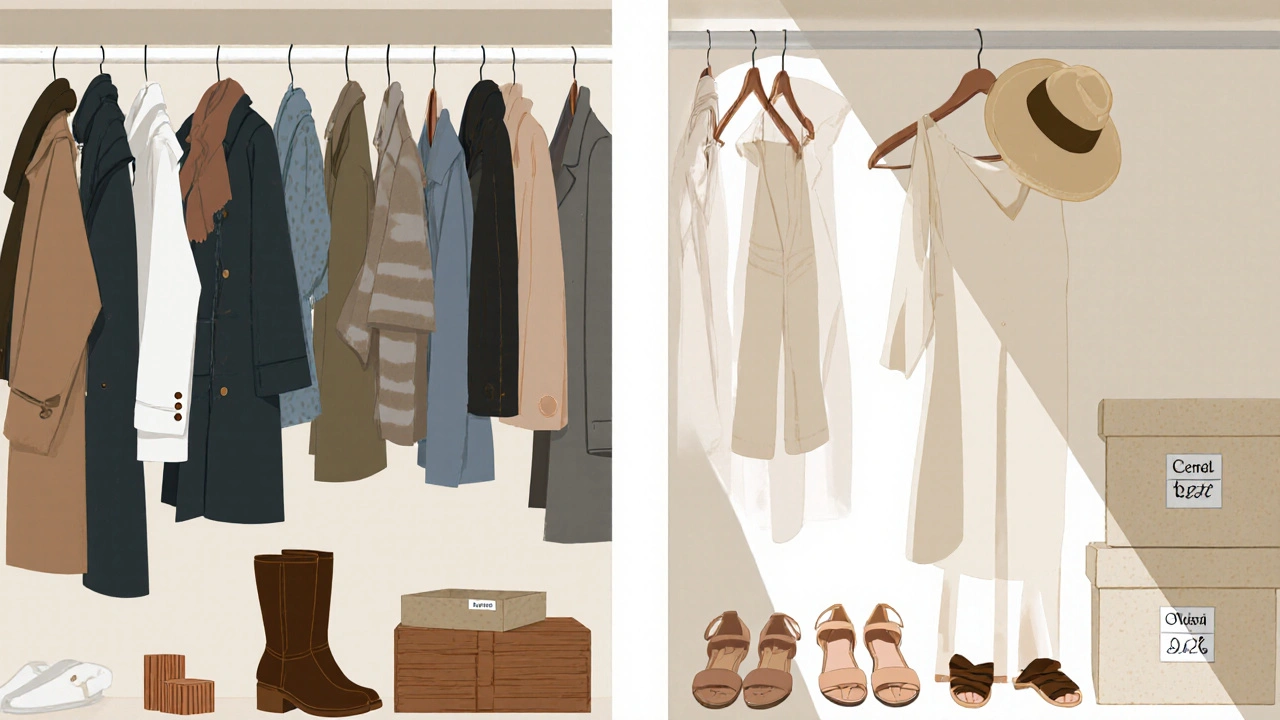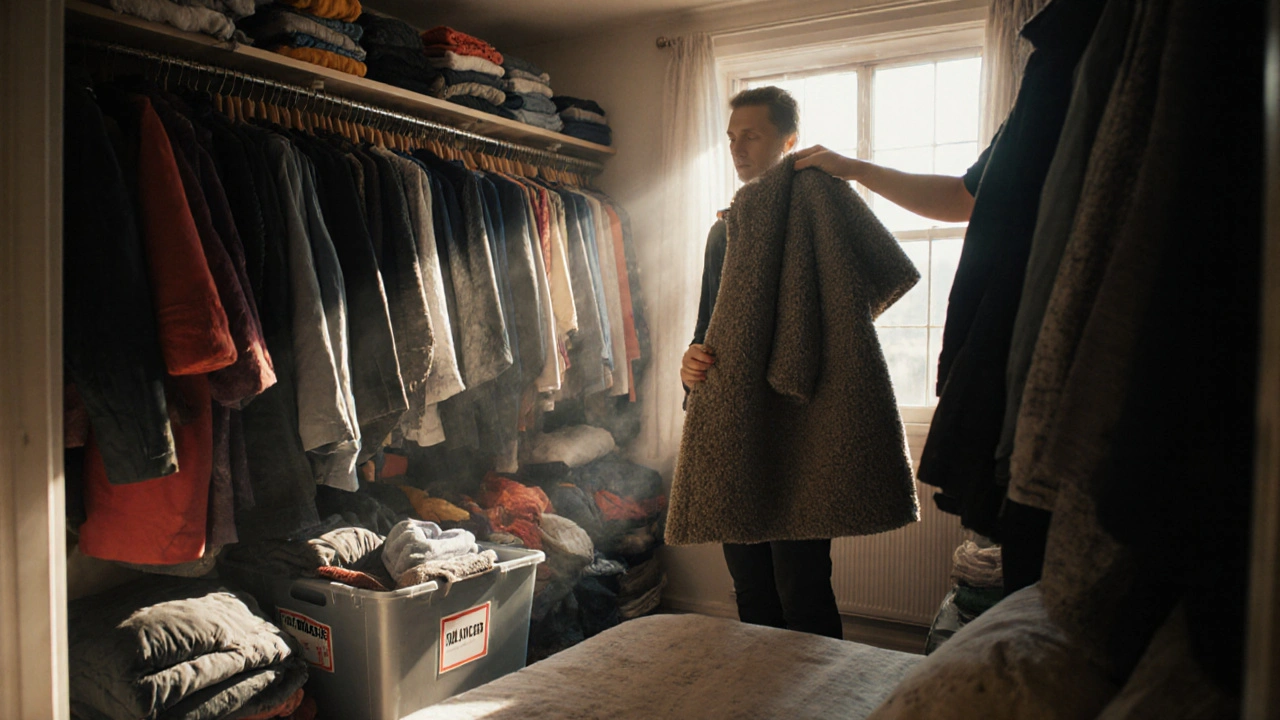Most people buy new clothes every season-spring coats, summer dresses, winter boots-and then stuff the old ones in the back of the closet. By fall, they’ve forgotten half of what they own. Then they buy more. It’s not just wasteful. It’s expensive. And it doesn’t have to be that way.
Why Your Closet Feels Empty Even When It’s Full
Ever opened your closet and thought, ‘I have nothing to wear’? That’s not because you lack clothes. It’s because you lack a system. You’ve got 12 sweaters, but only two of them actually match your current lifestyle. You’ve got a denim jacket you wore once in 2022, but now it’s buried under six pairs of jeans you never wear.
The problem isn’t quantity. It’s visibility and compatibility. When clothes aren’t organized by season or purpose, your brain doesn’t register them as options. You start thinking you need new stuff-when really, you just need to remember what you already have.
How Seasonal Wardrobe Rotation Works
Seasonal wardrobe rotation is simple: twice a year, you take everything out of your closet, sort it by season, and store what you won’t need for the next few months. Only the current season’s clothes stay accessible.
Here’s how it works in practice:
- Take everything out of your closet and drawers.
- Sort items into four piles: Spring/Summer, Fall/Winter, Never Worn, and Donate/Sell.
- Keep only the current season’s clothes in your main closet.
- Store off-season clothes in labeled bins under the bed, in a closet shelf, or in vacuum-sealed bags.
- Repeat every six months.
When you switch seasons, you don’t buy new outfits-you rediscover old ones. That navy blazer you forgot about? It pairs perfectly with your black turtleneck and jeans. That floral dress from last spring? It looks just as good now that you’ve styled it with a leather jacket.
How Much Money You Save
The average American spends about $1,700 a year on clothing. That’s $140 a month. If you cut that in half by reusing what you own, you save $850 a year. Over five years, that’s over $4,000.
But the real savings aren’t just financial. They’re mental. You stop feeling the pressure to keep up with trends. You stop scrolling through online stores at 2 a.m. You stop buying things you don’t need because you know exactly what you have-and what works.
In New York, where space is tight and winters are brutal, people who rotate their wardrobes don’t just save money. They save sanity. No more overflowing closets. No more ‘I need a new coat’ panic in October. Just a clean, manageable system that works year after year.

What to Keep, What to Let Go
Not every item deserves a spot in your rotation. Here’s what to ask yourself before storing or donating:
- Have I worn this in the last 12 months?
- Does it still fit well-not just in size, but in style?
- Is it in good condition? No stains, no holes, no stretched-out necklines?
- Does it go with at least three other pieces I own?
- Would I buy this again today if I didn’t already own it?
If you answer ‘no’ to two or more of those, it’s time to let it go. Don’t keep things ‘just in case.’ That’s how closets turn into storage units.
For items you’re unsure about, try a ‘maybe’ box. Put them in a bin and label it ‘2025 Maybe.’ If you don’t reach for anything in that box during the next season, donate it without guilt.
Make It Work for Your Lifestyle
Rotation isn’t one-size-fits-all. If you work from home, you might not need a full winter coat collection. If you commute in the rain, you need one great waterproof jacket-not three. If you go out often, prioritize versatile pieces: a black blazer, dark jeans, neutral boots, and a few layering pieces.
Here’s what a minimalist seasonal rotation looks like in real life:
- Winter (Nov-Mar): 5 tops, 3 bottoms, 2 coats, 1 pair of boots, 3 scarves, 1 hat, 1 pair of gloves.
- Summer (May-Sep): 6 tops, 4 shorts/skirts, 1 light jacket, 1 pair of sandals, 2 sun hats, 1 pair of sunglasses.
That’s it. No more. No less. And it’s enough. You don’t need 20 sweaters. You need three that you love, that fit, and that you actually wear.
Storage Tips That Actually Work
Storing off-season clothes isn’t just about tossing them in a box. It’s about keeping them clean, dry, and ready to wear.
- Wash everything before storing. Sweat, perfume, and body oils attract moths and cause yellowing.
- Use breathable cotton storage bags, not plastic. Plastic traps moisture and can mildew.
- Place cedar blocks or lavender sachets in bins to repel insects naturally.
- Label everything clearly: ‘Winter Tops,’ ‘Fall Outerwear,’ etc.
- Store bins under the bed or on high shelves-out of the way, but easy to reach.
If you have a spare closet, use it. If not, under-bed bins with wheels work great. The goal isn’t perfection-it’s accessibility. You want to be able to open a bin and find exactly what you need without digging through five others.

What Happens After You Start
Once you rotate your wardrobe for the first time, something changes. You stop seeing clothes as disposable. You start seeing them as tools-each one chosen for a purpose.
You’ll notice how many outfits you can make with just seven tops and four bottoms. You’ll realize your favorite pair of jeans has lasted five winters. You’ll feel proud when someone compliments your outfit-and you didn’t buy it new.
And when you do buy something new, you’ll do it differently. You won’t buy on impulse. You’ll ask: ‘Does this fill a gap?’ ‘Will I wear it at least 30 times?’ ‘Can I style it with what I already own?’
That’s the real win. Not just saving money. It’s gaining control.
How to Stick With It
The biggest reason people quit seasonal rotation? They forget. Life gets busy. The seasons change. And suddenly, your winter coat is still in the closet in April.
Set a reminder. Twice a year-on March 1 and September 1-block out two hours to rotate. Put it on your calendar like a doctor’s appointment. Do it while listening to a podcast or your favorite playlist. Make it part of your routine.
After the first time, you’ll see how easy it is. After the second, you’ll wonder why you didn’t start sooner.
What This Really Is
Seasonal wardrobe rotation isn’t a trend. It’s a practical response to a broken system. Fast fashion tells us to buy more. But your wallet, your space, and your peace of mind tell you otherwise.
This is budget fashion done right. Not by buying cheaper stuff. But by using what you already have-better.
You don’t need a bigger closet. You need a smarter one.
How often should I rotate my wardrobe?
Rotate your wardrobe twice a year-once in early spring (March) and once in early fall (September). This aligns with seasonal weather changes and keeps your closet manageable. Mark these dates on your calendar so it becomes a habit, not an afterthought.
What if I don’t have storage space?
You don’t need a walk-in closet. Under-bed storage bins, vacuum-sealed bags, or even a labeled laundry basket in a corner work fine. The key is keeping off-season clothes out of sight but easy to access. If you’re short on space, be ruthless: only store what you’ve worn in the last year.
Can I still buy new clothes with this system?
Yes-but only if you truly need it. Before buying, ask: ‘Does this fill a gap?’ and ‘Can I style it with at least three things I already own?’ If the answer is no, wait. Most of the time, you’ll realize you already have something that works.
What if I hate the clothes I own?
If you genuinely dislike what’s in your closet, start small. Pick one item you tolerate and style it differently. Pair a plain tee with a belt or layer it under a vest. Sometimes, it’s not the clothes-it’s how you see them. If after a few tries you still hate them, donate them and replace one piece at a time with items you love.
Does this work for kids’ clothes?
Absolutely. Kids outgrow clothes fast, so rotation helps you reuse hand-me-downs and seasonal items more efficiently. Store outgrown clothes in labeled bins by size and season. When the next season comes, pull them out and see what fits. You’ll save hundreds every year on kids’ clothing.
How do I know if I’ve gone too far and removed too much?
If you find yourself reaching for the same three outfits every day, you might be missing variety. Add one or two new pieces that match your existing style. But don’t panic-most people think they’ve removed too much, then realize they never wore the rest anyway. Trust the process.
Start your next rotation on September 1. You’ll thank yourself by winter.


Write a comment